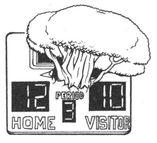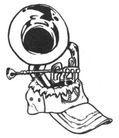How to Remember Anything: The Proven Total Memory Retention System (28 page)
Read How to Remember Anything: The Proven Total Memory Retention System Online
Authors: Dean Vaughn

October: see the
scoreboard
with a
tree
stuck in it! (
Scorpio: tree, 3, 23
)

November: see the
satchel
with a
tuba
in it! (
Sagittarius: tuba, 2, 22
)

December: see the
cap
with a
tuba
in it! (
Capricorn: tuba, 2, 22
)

I recognize there are different opinions about the precise date on which some of the signs begin. It’s easy to change the associations to adjust to the dates you use if they are different than those indicated here. You now have a simple method for determining, not only the month, but the day of the month on which each sign begins.
HOW TO REMEMBER WHERE YOU PUT THINGS
How many times have you said, “I can’t find my keys / glasses / new pen /
cell phone”? How much time have you spent looking for things you’ve misplaced? Finally, there is a way to remember where you put things. For each item you put somewhere, it will take about two seconds to lock it in your mind so you’ll know where it is when you need it.
I am going to place five common items in different locations and use a simple, organized system to show you how to remember where each item is placed.
Let’s start with your sunglasses. You place your sunglasses in a drawer in your bedroom. As you place your sunglasses in the drawer, stop just for a second, look at the sunglasses and imagine a gigantic drawer being pulled out of the sunglasses (out through the lens). Think to yourself, sunglasses—see the drawer being pulled out through the lens—drawer. Later, when you think, “Sunglasses,” you’ll remember the drawer being pulled out of the lens and remember that the sunglasses are in the drawer.
You place your car keys under a pillow on the sofa. As you place your keys under the pillow, stop just for a second, look at the keys and imagine using the pillow instead of your keys to unlock and start your car! Think to yourself, car keys—see yourself using the pillow to unlock and start your car—pillow. Later, when you think, “Car keys,” you’ll remember trying to unlock and start your car with the pillow and remember that the car keys are under the pillow.
You place your new pen under a desk lamp. As you place your new pen under the desk lamp, stop just for a second, look at the new pen and imagine it with a lamp shade on it (the same lamp shade on the lamp under which you place the new pen). Think to yourself, new pen—imagine the new pen with the lamp shade on it—lamp shade. Later, when you think, “New pen,” you’ll remember the new pen with the lamp shade on it and remember that the new pen is under the lamp.
You place your gloves in a pair of shoes you seldom wear. As you place your gloves in the shoes, stop just for a second, look at the gloves and imagine wearing the shoes on your hands instead of the gloves. Think to yourself, gloves—imagine wearing the shoes instead of the gloves—shoes. Later, when you think, “Gloves,” you’ll remember wearing shoes for gloves and recall that you put your gloves in the shoes.
You place your new credit card in an empty water glass (until you have time to put it in your purse or wallet). As you place your new credit card in the glass, stop just for a second, look at the credit card, and imagine paying for everything with the glass instead of your credit card. Think to yourself, credit card—imagine using a glass for a credit card—glass. Later, when you think, “Credit card,” you’ll remember using the glass as a credit card and recall that you placed your new credit card in the empty water glass. You’ll naturally recall where the glass is located.
Now, recall where you put each of these items: new pen, car keys, credit card, sunglasses, gloves.
The concept of “a place for everything and everything in its place” has a lot of merit. The idea here is that when you put anything anywhere that is
not
in its normal place, stop for a second or two and create a simple, illogical association between the item you place and where you place it. Compare the couple of seconds it will take to mentally store where you put the item to the many minutes or hours you may spend looking for it if you don’t do it! The habit is good; the system works and it saves a lot of time.
Using the same method, look at each item that follows and Where You Put It. Create an association for each of them. Then, cover the Where You Put It column. Look at each item and recall where you put it. Uncover to check your answers.
| Item | Where You Put It |
|---|---|
| special ring | in a glass jar in the kitchen pantry |
| black leather belt | top shelf in bedroom closet |
| letter to be mailed to a friend | inside kitchen cabinet with drinking glasses |
| postage stamps | top of refrigerator |
| digital camera | behind clock in bedroom |
| twelve-inch ruler | on shelf in entryway closet |
| chewing gum | in a cup in the kitchen cabinet |
| magnifying glass | in cabinet under the TV |
| flashlight | under the kitchen sink |
| calculator | behind telephone on nightstand in bedroom |
HOW TO REMEMBER YOUR SCHEDULE AND THINGS TO DO
A simple and easy way to remember your schedule and things to do is to
use the numbered Cube. I use different rooms for my schedule than the ones I use for my mental to-do list.
Let’s start with a to-do list. Visualize a familiar room. Each to-do item must be converted to something you can see. Let’s suggest that you must get your car inspected. You could just visualize your car in location 1 of the room you are using for your to-do list. Imagine your car bursting out of location 1 of the to-do room.
Number 1 has no significance, other than it just happens to be the first item you placed on the list. The next item would be placed at the next location—the left wall.
If the next thing on the list is to pick up items at the dry cleaner, just imagine the next location in your to-do room and imagine dry-cleaning items piled from the floor to the ceiling at that location.
With this system, you can start with an initial list and add to it at any time. When you complete an item in a room location, you can replace it with another item. For example, if you want to add another item to the to-do list, such as sending a thank you card to a friend, and you already had your car inspected, you can just replace the car with a gigantic thank you card in the same location. So, instead of seeing the car at the back left corner of the to-do room, you now see a gigantic thank you card bursting out of the corner.
If you have not yet picked up the dry cleaning, it will still be stacked up at the left wall. It is easy to review ten items in the to-do list in just one room. If you need more than ten items at a time, use additional rooms.
The system you use for remembering your schedule depends on how busy your schedule is. Some people use one room for each day of the week. Others can get by with a single room. I use seven rooms for the seven days of the week.
The system is identical to the to-do room described earlier, except that I add (using the Number Code) the time of day, if that is necessary. Here is an example: if I have an appointment on Wednesday, I use my Wednesday room. If the appointment is at 9:45 A.M. I use the Code Word
pearl
(which converts to 945 with the Number Code). Natural memory is sufficient to know if it is A.M. or P.M.
I just link the
pearl
to the object I use for the appointment itself. If I later add another appointment that is earlier than 9:45 A.M. I put it in the next available room location, even though it is to occur earlier than the item in the location before it. It is so easy to mentally scan the appointments for the day that it does not make any difference in which sequence they occur in the room.
When you start using the Cube for to-do things and for your schedule, you will want to keep using it because it is quick and efficient. It is also great for mental exercise. It is just one of many mental activities that will help keep you mentally alert for a lifetime.
STATES AND THE DATES THEY ENTERED THE UNION
Here is a handy application for practice and a great history lesson. I suggest
that you learn all the states first, then start over and add the dates they entered the Union. You will then know the date in which each state entered the Union, because the second object will give you the actual year.
Start with location 1—the back left corner of your Units room.
1.
At location 1, see a
deli (Delaware)
with a gigantic
fig
(17
87
) in it!
2.
At location 2, see a
pencil (Pennsylvania)
with a gigantic
fig
(17
87
) on it!
3.
At location 3, see a
new (football) jersey (New Jersey)
with a huge
fig
(17
87
) on it!
4.
At location 4, see
George Washington (Georgia)
playing a
fife
(17
88
)!
5.
At location 5, see a
cone (Connecticut)
with a gigantic
fife
(17
88
) stuck in it!
6.
At location 6, see a
mast (Massachusetts)
of a ship with a gigantic
fife
(17
88
) stuck through it!
7.
At location 7, see
Mary’s lamb (Maryland)
with a gigantic
fife
(17
88
)!
8.
At location 8, see
southern carolers (South Carolina)
holding a gigantic
fife
(17
88
)!
9.
At location 9, see a
new ham (New Hampshire)
with a gigantic
fife
(17
88
) stuck in it!
10s Room
10.
At location 10, see a gigantic
Virginia ham (Virginia)
with a huge
fife
(17
88
) stuck in it!